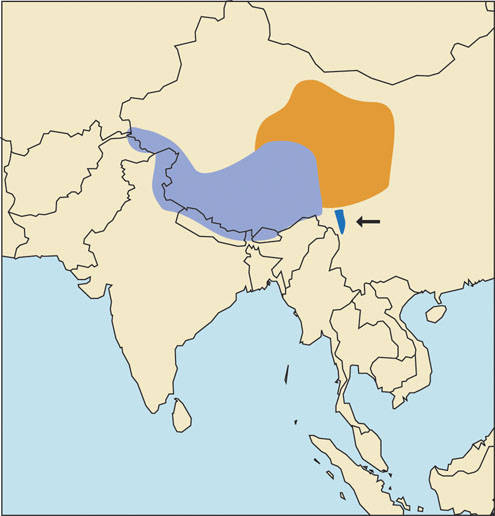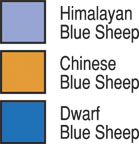 |
 |
Pseudois schaeferi
Baral enano (Sp), Zwergblauschaf (G), Bharal nain (F). Also called pygmy blue sheep. The species name is for German naturalist Ernst Schäfer, who with British naturalist and expedition leader Brooke Dolan, in 1934 collected the first specimens to be examined by Western scientists.
DESCRIPTION Much smaller than other forms of blue sheep, with a drab coloration and very small horns. Schäfer reported head and body lengths, including tail, of 50-54 inches (127-138 cm), shoulder heights of 29-31 inches (74-80 cm), and weights of 55-85 pounds (25-39 kg). The summer coat is a dull brownish-gray, with the head, neck, dorsal area, tail tip, and front of legs darker. Underparts, inside of legs, and inside of ears are whitish, and there is a light ring around the eyes. The winter coat is bright silver-gray, with the colors more pronounced, and there is a black stripe separating flanks from belly. The horns are much smaller than in other blue sheep. Females have very small, straight horns.
BEHAVIOR Lives in small groups in open, grassy areas, avoiding brush and forest. Active mainly at dawn. Feeds mostly on grasses.
DISTRIBUTION Dwarf blue sheep have a limited distribution in the upper Jinsha Jiang (Yangtze River) gorge near Leh and Drupalong and south of Batang in western Sichuan and southeastern Tibet. They are usually found at elevations of 8,500-10,500 feet (2,600-3,200 m), and are cut off from the blue sheep populations of the upper grassy altitudes of the same region by a thick, scrubby forest 3-4 miles (5-6 km) across and covering 1,500 feet (450 m) of elevation.
TAXONOMIC NOTES Although discovered by Western science in 1934, the dwarf blue sheep was neither classified nor given a scientific name until Haltenorth did so in 1963, designating it as a subspecies of P. nayaur. In 1978, Groves recognized it as a full species (P. schaeferi), and this now is generally accepted.
REMARKS Western science knows relatively little about this isolated animal. However, in 1988, a Chinese scientific expedition conducted a field study from May to November and confirmed Groves' opinion that it should be ranked as a distinct species, rather than a subspecies. It collected 33 skulls and 53 food specimens, and reported the population increasing, with a high percentage of young animals.
Locals believe July is the best time to hunt these animals, because then the grass is better at lower elevations (8,200 feet, 2,500 m) and the blue sheep descend to feed on it.
|





